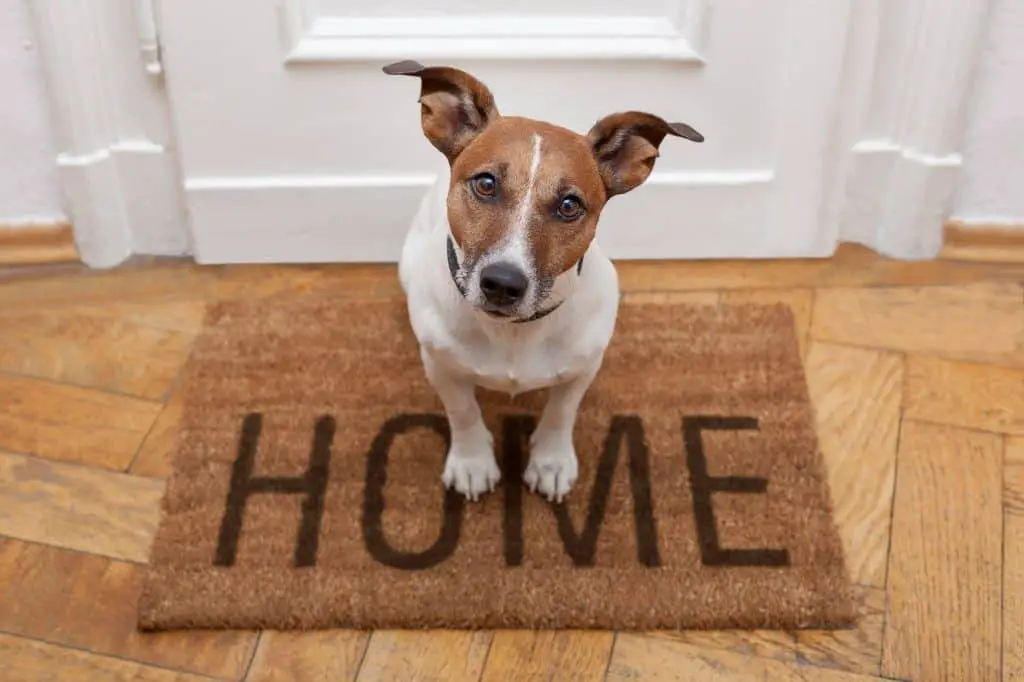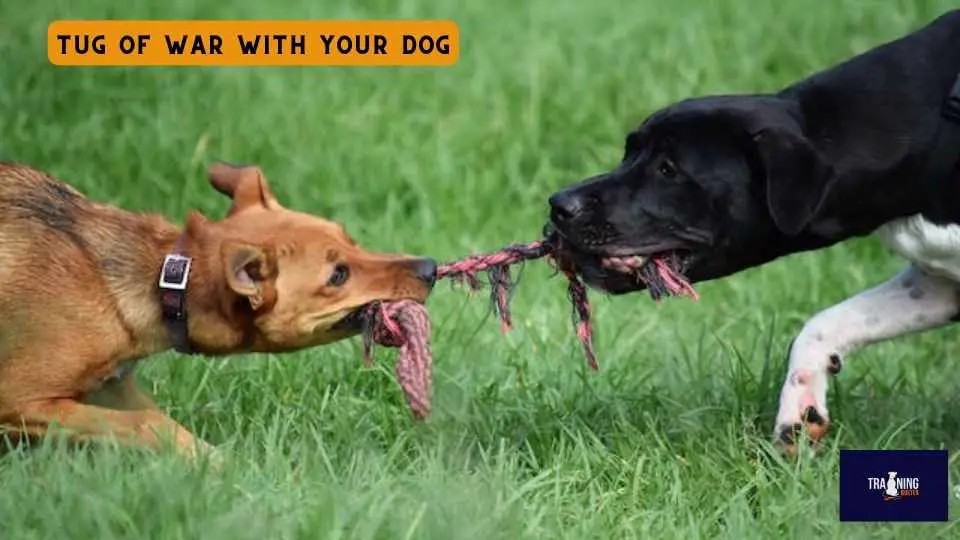
Playing tug of war with your dog can be a fantastic way to engage in interactive play and build a stronger bond. However, it’s crucial to approach this game with the right knowledge and techniques to ensure it remains safe, fun, and reinforces positive behavior.
In this article, we will explore the ins and outs of playing tug of war with your furry friend, providing you with practical tips on how to engage in this activity properly.
From selecting the right tug toy to establishing rules and maintaining control, we will guide you through the process of playing tug of war in a positive and controlled manner.
So, let’s dive in and discover how you can create a rewarding and fulfilling tug-of-war experience for both you and your beloved canine companion.
1. Choose the Right Tug Toy
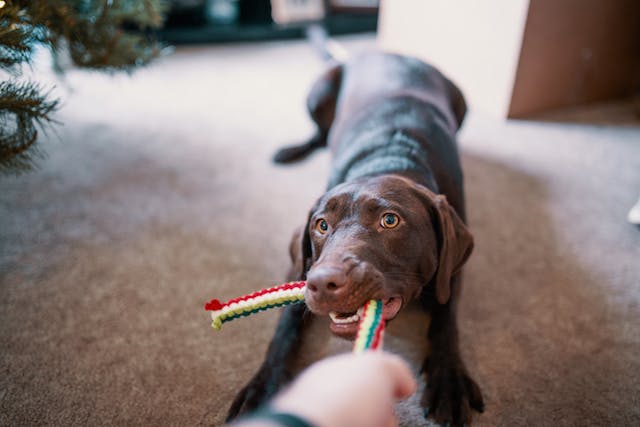
Selecting the appropriate tug toy is essential for a safe and enjoyable game of tug of war.
Maybe your dog’s favorite toy is an old dirty sock or whatever they can get their paws on in the trash can, but opt for a sturdy, dog-specific tug toy that can withstand your dog’s pulling and tugging without easily breaking.
Look for toys made from durable materials like rope, rubber, or nylon. Avoid using things like old socks or clothing, as they can confuse your dog about what is okay for them to chew on.
If your dog brings you something like this, try offering them one of their toys to play tug of war with instead.
2. Establish Ground Rules
Before starting the game, it’s important to establish clear ground rules and boundaries.
Teach your dog basic obedience commands such as “take it” to initiate play and “drop it” to release the toy when asked. Consistently reinforce these commands through positive reinforcement, such as treats and praise.
Setting these rules creates structure and control during the game. It’s never too late to start establishing these ground rules for future safety and enjoyment!
Plus, knowledge of commands like “take it” and “drop it” can come in handy when you’re working on other skills together, too – you never know when you may want your pooch to drop something dangerous, or take an object over to someone.
3. Control the Game
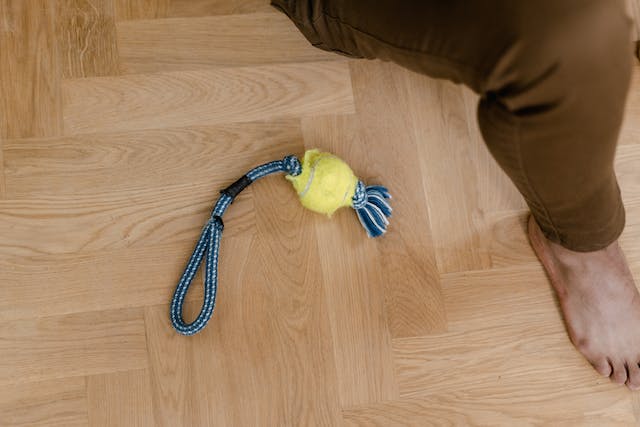
Maintaining control during the game is crucial to ensure it remains safe and enjoyable for both you and your dog.
Control the intensity of the tugging by using gentle yet firm pressure. Though some gentle tugging is a key part of the game of tug of war, avoid excessive pulling or jerking, as this can lead to accidental injuries on both parts or could encourage aggressive behavior.
Encourage your dog to play with enthusiasm but within controlled limits. The game should be fun, but you want to prevent either of you getting injured while playing tug of war.
Make sure your pooch isn’t about to bump into any household furniture, and check that you won’t be bumping into anything surrounding you, either.
If your dog is small, don’t lift them – they could be hurt if they fall onto the floor. You could even consider moving your game to a soft surface, like a mat or patch of grass, to further eradicate the risk of injury if play becomes intense!
4. Encourage Appropriate Behavior
While playing tug of war, it’s important to encourage and reward appropriate behavior.
Reinforce your dog’s understanding of the rules by praising and treating them when they respond correctly to commands like “take it” and “drop it.”
Positive reinforcement helps strengthen the desired behavior and promotes a positive association with the game.
5. Take Breaks and Rotate Toys
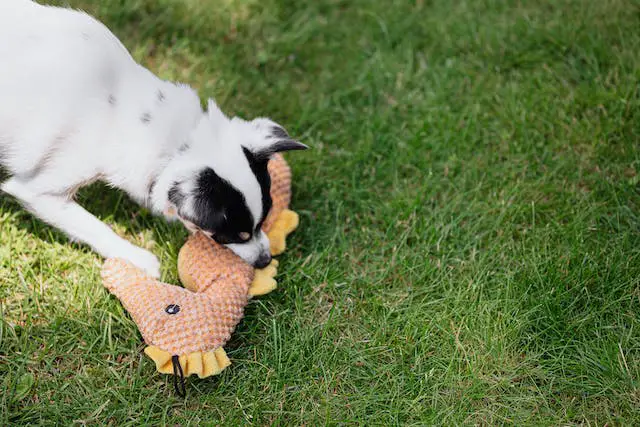
To prevent overstimulation and potential possessiveness over the toy, take short breaks during the game.
Use these breaks to allow your dog to calm down and refocus. Additionally, it’s a good practice to rotate tug toys to avoid fixation on a particular toy, as this can lead to possessive behavior.
6. Monitor Body Language
Closely observe your dog’s body language throughout the game. Pay attention to any signs of discomfort, fear, or aggression.
Signs like growling, snarling, stiffening, freezing, or showing signs of distress should be taken seriously. If you notice any of these signs, immediately stop the game and assess the situation.
7. Supervise and Ensure Safety
When playing tug of war with your dog, it’s crucial to supervise the game and prioritize safety at all times.
Keep an eye on the interaction between you and your dog to prevent any accidents or injuries. Make sure the playing area is free of any hazards or objects that could be knocked over or cause harm.
Additionally, be aware of your dog’s size and strength compared to your own. Larger and stronger dogs may inadvertently exert too much force during the game, potentially causing strain or injury.
If you feel overwhelmed or unable to control the game, it’s better to discontinue the activity and seek professional guidance.
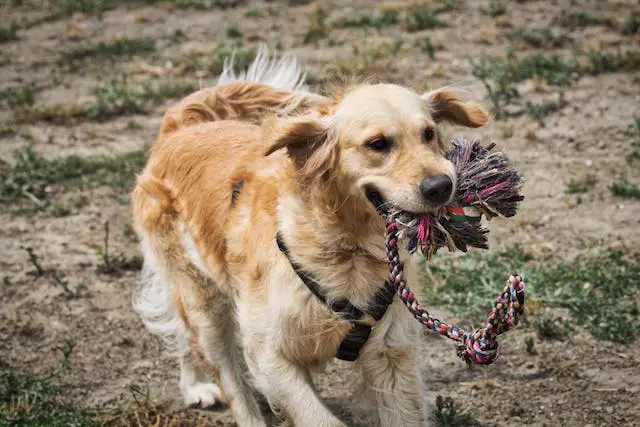
Furthermore, if you have multiple dogs, it’s important to ensure that the game doesn’t escalate into aggressive behavior or resource guarding.
Some dogs may become possessive of the tug toy, leading to conflicts. In such cases, it’s advisable to engage each dog in separate play sessions or use multiple toys to avoid competition.
However, it’s also okay to hand your end of the toy over to another dog, as long as you supervise the dogs.
By closely supervising the game and prioritizing safety, you can create a secure and enjoyable environment for both you and your dog during tug-of-war sessions.
8. End on a Positive Note
Ending the game on a positive note is essential for reinforcing good behavior and maintaining a positive association with tug of war.
Ask your dog to “drop it” and reward them with praise, treats, or an alternative reward when they release the toy. This teaches your dog that following your commands leads to positive outcomes.
Of course, you can always pick the toy back up and start playing again immediately afterwards but you want to teach your pooch to stop when you ask.
9. Let Your Dog Lead
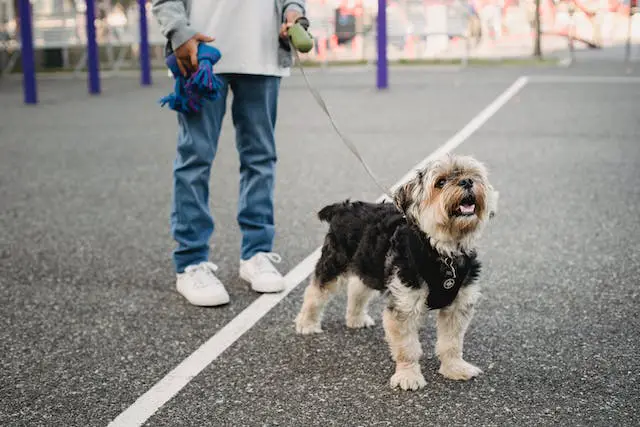
Yes, learning commands like “drop it” and “take it” are important. But what if your dog wants to change things up a bit when you play tug of war together?
If your dog has the tug toy and runs off with it, showing body language like wagging their tail, it’s fine for you to chase after your pooch a little. This is simply them wanting to play chase with you!
If you catch them, you can always go back to playing tug of war again. This isn’t your dog being disobedient or anything. Equally, it’s fine to throw the tug of war toy and start playing fetch, too.
Playing tug of war can provide mental and physical stimulation for your dog, promote obedience, and strengthen the bond between you. It’s an excellent opportunity for interactive play and can be a fun way to channel your dog’s natural instincts.
However, it’s important to be mindful of your dog’s individual temperament, health, and behavior. If your dog has a history of possessiveness or aggression or has any dental or health issues, consult with a professional dog trainer or veterinarian before engaging in tug of war.
Remember, the goal of playing tug of war is to have a positive and enjoyable experience for both you and your dog. With the right approach, this game can be a wonderful addition to your playtime routine and further deepen the connection between you and your furry friend.
So, grab a suitable tug toy, set the rules, and embark on a safe and joyful tug-of-war adventure with your beloved canine companion.


